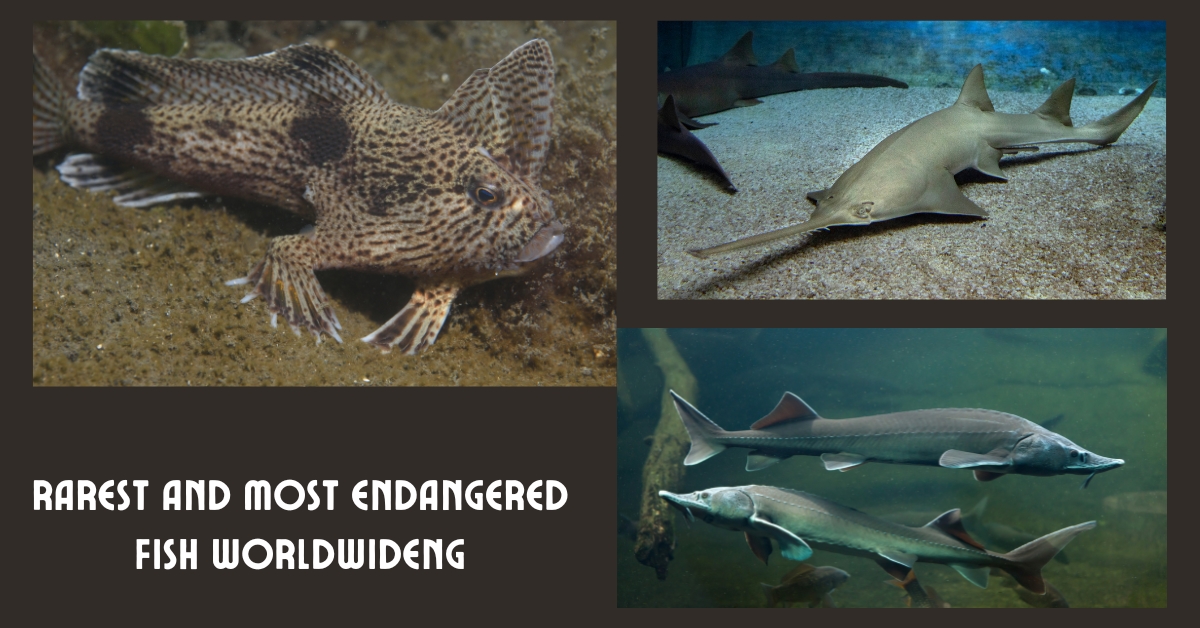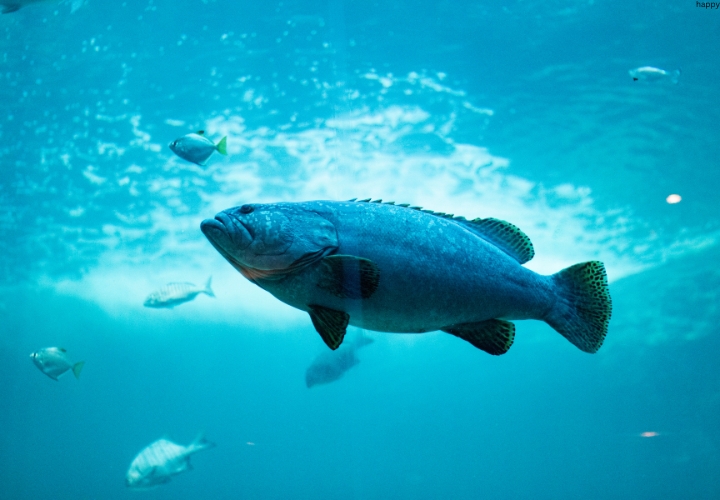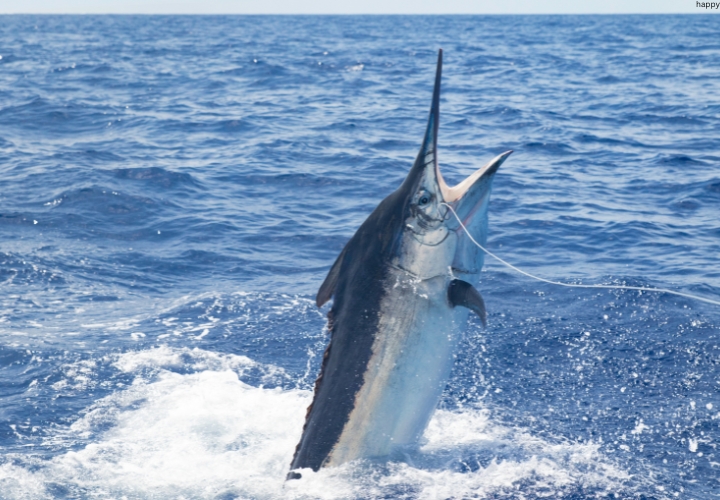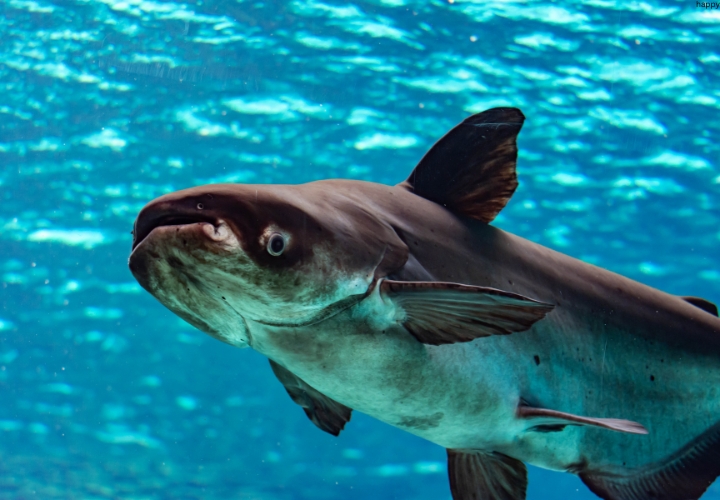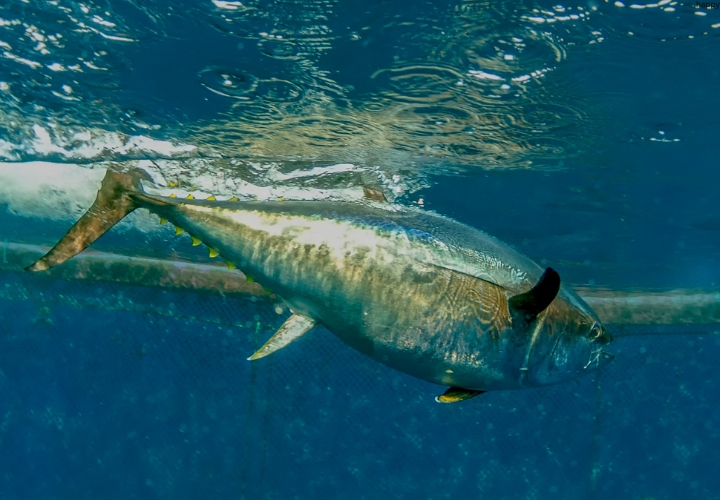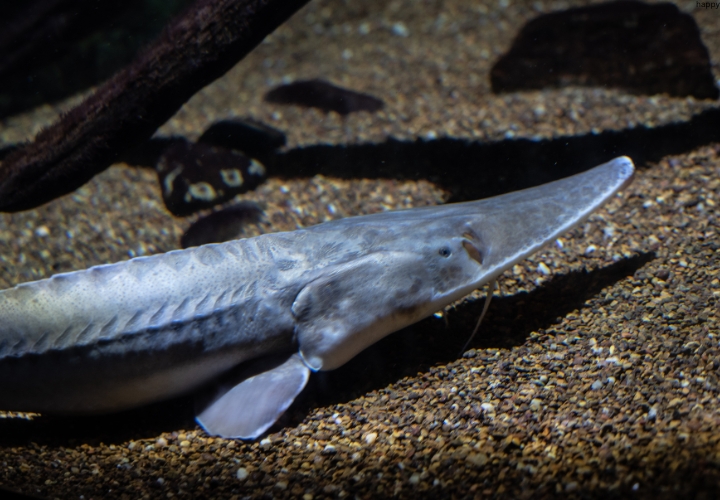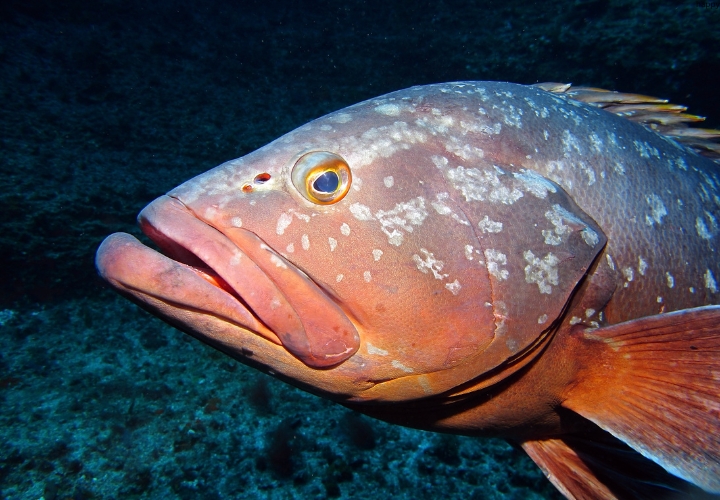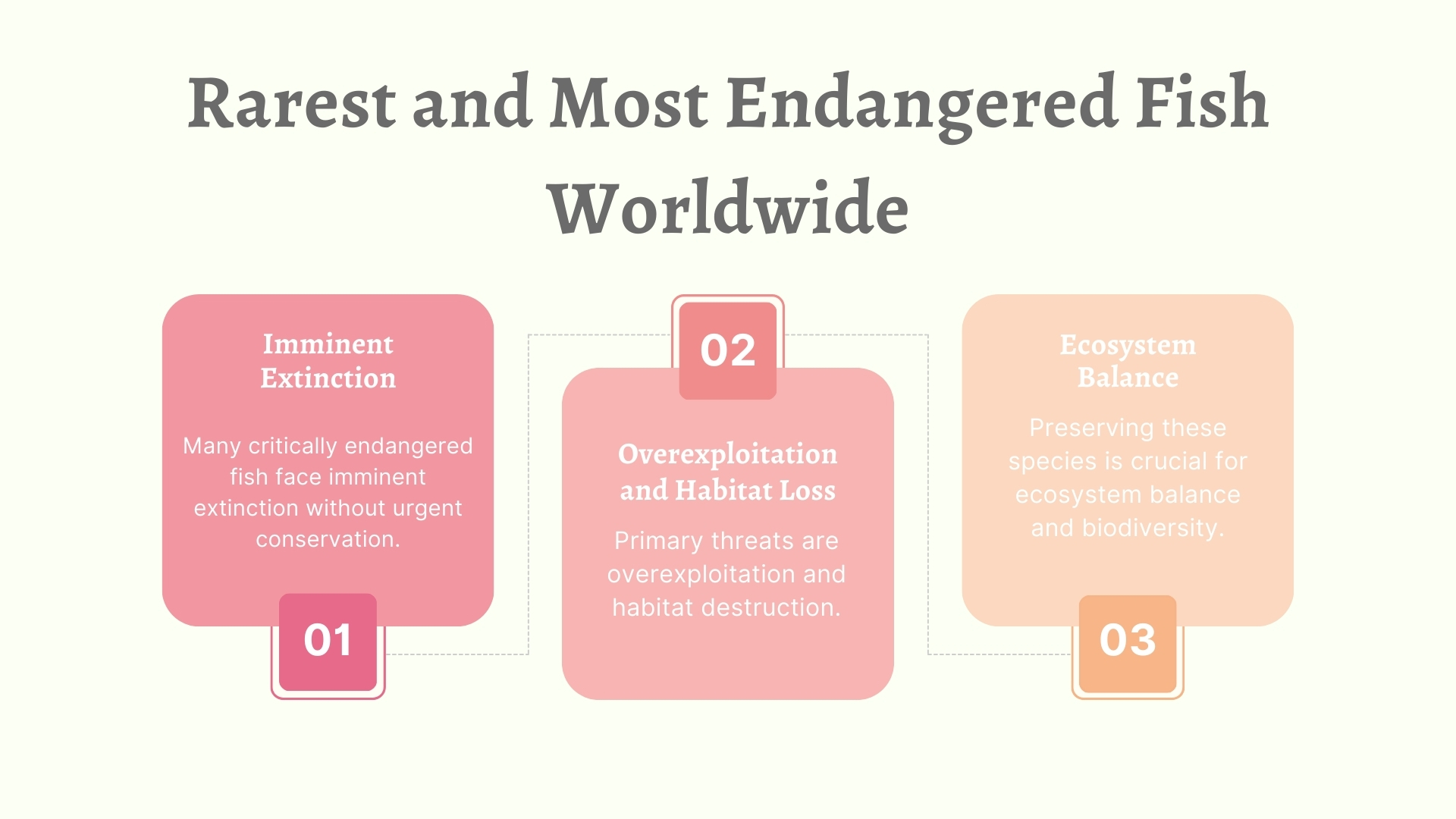Our world’s oceans, lakes, and rivers are home to a vast array of aquatic life, from the colorful coral reefs to the mysterious depths.
However, many of these fascinating fish species face a grim reality – they are on the brink of extinction, pushed to the edge by a variety of threats.
In this blog post, we will explore 20 of the rarest and most endangered fish species found across the globe.
What Makes a Fish Endangered?
Fish can become endangered for several reasons, often due to human activities. Some of the primary threats to fish populations include:
- Overfishing: Excessive, unregulated, or illegal fishing can deplete fish stocks faster than they can naturally replenish.
- Habitat Destruction: Activities like coastal development, pollution, and climate change can destroy or degrade the natural habitats that fish rely on.
- Invasive Species: The introduction of non-native fish species can outcompete and displace native fish populations.
- Disease and Parasites: Diseases and parasites can spread more easily in overcrowded or stressed fish populations.
- Climate Change: Rising temperatures, ocean acidification, and other climate-related changes can disrupt the delicate balance of aquatic ecosystems.
Rarest and Most Endangered Fish Worldwide
1. Totoaba
The critically endangered Totoaba, found only in the Gulf of California, Mexico, faces threats from overfishing and the illegal wildlife trade due to the high demand for its swim bladder in traditional Chinese medicine.
Characteristics:
- Large, silvery-white fish up to 2 meters in length
- Important predator, maintaining ecosystem balance
Habitat:
- Gulf of California, Mexico
2. Smalltooth Sawfish
The critically endangered Smalltooth Sawfish, a ray species found in the western Atlantic, is threatened by overfishing and habitat destruction, particularly in its nursery areas.
Characteristics:
- Distinctive saw-like snout used to locate and stun prey
- Slow-growing and late-maturing species
Habitat:
- Shallow, coastal waters of the western Atlantic Ocean
3. Yangtze Sturgeon
The critically endangered Yangtze Sturgeon, found only in China’s Yangtze River, faces threats from overfishing and habitat destruction due to dam construction and development projects.
Characteristics:
- Large, ancient species of sturgeon
- Can grow up to 3 meters in length and live over 100 years
Habitat:
- Yangtze River, China
4. Smooth Handfish
The critically endangered Smooth Handfish, found in a small area off the coast of Tasmania, Australia, is threatened by habitat destruction and invasive species.
Characteristics:
- Unique “walking” locomotion using pectoral fins
- One of the rarest and most evolutionarily distinct fish species
Habitat:
- Coastal waters off Tasmania, Australia
5. Ivory-nut Marlin
The critically endangered Ivory-nut Marlin, found in the eastern Pacific Ocean, is threatened by overfishing due to its large size and distinctive appearance, making it a highly sought-after target.
Characteristics:
- Large, predatory fish up to 4 meters in length
- Distinctive white coloration and long, spear-like bill
Habitat:
- Eastern Pacific Ocean
6. European Sturgeon
The critically endangered European Sturgeon, found in European rivers and coastal waters, faces threats from overfishing and habitat destruction, including the construction of dams and other infrastructure projects.
Characteristics:
- Large, slow-growing species that can live over 100 years
- Important cultural and economic resource
Habitat:
- Rivers and coastal waters of Europe
7. Chinese Sturgeon
The critically endangered Chinese Sturgeon, found only in China’s Yangtze River, is threatened by overfishing and habitat destruction from dam construction and other development projects.
Characteristics:
- Distinctive, ancient species with a long, slender body and protruding snout
- Adapted to feed on small fish and invertebrates from the river bed
Habitat:
- Yangtze River, China
8. Giant Catfish
The critically endangered Giant Catfish, found in the Mekong River basin of Southeast Asia, is threatened by overfishing and habitat destruction, including the construction of dams and other infrastructure projects.
Characteristics:
- World’s largest freshwater fish, reaching over 3 meters in length and 300 kg in weight
- Important food source and ecosystem role in the Mekong River basin
Habitat:
- Mekong River basin, Southeast Asia
9. Sakhalin Sturgeon
The critically endangered Sakhalin Sturgeon, found in the Amur River basin of Russia and China, faces threats from overfishing and habitat destruction due to dam construction and other infrastructure projects.
Characteristics:
- Large, slow-growing sturgeon species that can live over 100 years
- Important cultural and economic resource in the Amur River basin
Habitat:
- Amur River basin, Russia and China
10. Orange Roughy
The vulnerable Orange Roughy, a deep-sea fish found in the Southern Hemisphere, is threatened by overfishing due to its slow growth and late maturity.
Characteristics:
- Distinctive orange-red coloration and large, bulbous head
- Long-lived species, with some individuals living over 100 years
Habitat:
- Deep-sea waters of the Southern Hemisphere
11. Atlantic Bluefin Tuna
The endangered Atlantic Bluefin Tuna, found in the western and eastern Atlantic Ocean and the Mediterranean Sea, is threatened by overfishing due to the high value of its meat and fatty tissues.
Characteristics:
- Massive fish, reaching over 3 meters in length and 600 kg in weight
- Important predator in marine ecosystems, feeding on smaller fish, squid, and crustaceans
Habitat:
- Western and eastern Atlantic Ocean, Mediterranean Sea
12. Devil’s Hole Pupfish
The critically endangered Devil’s Hole Pupfish, found only in a single, isolated pool in the Amargosa Desert of Nevada, USA, is threatened by habitat destruction and climate change.
Characteristics:
- Small, colorful fish adapted to the harsh, arid conditions of its native habitat
- One of the rarest and most endangered vertebrate species in the world
Habitat:
- Single, isolated pool in the Amargosa Desert, Nevada, USA
13. Pallid Sturgeon
The endangered Pallid Sturgeon, found in the Missouri and Mississippi River basins of the central United States, is threatened by habitat destruction, dam construction, and invasive species.
Characteristics:
- Large, slow-growing sturgeon species that can live over 50 years
- Important predator and ecosystem maintainer in its native rivers and streams
Habitat:
- Missouri and Mississippi River basins, central United States
14. Borneo Earless Catfish
The critically endangered Borneo Earless Catfish, found only in a small region of Sarawak, Malaysia, is threatened by habitat destruction due to logging and deforestation.
Characteristics:
- Unique species characterized by the lack of external ears and a small, slender body
- Important part of the aquatic ecosystem in its native rainforest streams and rivers
Habitat:
- Streams and rivers in the rainforests of Sarawak, Malaysia
15. Saddled Bichir
The critically endangered Saddled Bichir, found only in a small region of Lake Tanganyika in Africa, is threatened by habitat destruction due to overfishing and pollution.
Characteristics:
- Distinctive, ancient species with a large, elongated body and a unique pattern of dark and light stripes
- Important part of the aquatic ecosystem in Lake Tanganyika
Habitat:
- Lake Tanganyika, Africa
16. Dusky Grouper
The endangered Dusky Grouper, found in the Mediterranean Sea and along the Atlantic coast of Africa, is threatened by overfishing due to its large size and slow growth.
Characteristics:
- Large, predatory fish that can grow up to 1.5 meters in length and weigh up to 100 kg
- Important top predator in marine ecosystems
Habitat:
- Mediterranean Sea, Atlantic coast of Africa
17. Shortnose Sturgeon
The endangered Shortnose Sturgeon, found in the rivers and coastal waters of the eastern United States, is threatened by habitat destruction, particularly from the construction of dams and other infrastructure projects.
Characteristics:
- Large, slow-growing sturgeon species that can live over 60 years
- Important predator and ecosystem maintainer in its native rivers and coastal waters
Habitat:
- Rivers and coastal waters of the eastern United States
18. Coelacanth
The critically endangered Coelacanth, thought to have gone extinct millions of years ago until its rediscovery in the 1930s, is threatened by overfishing and habitat destruction in its native waters off the coast of Africa.
Characteristics:
- Unique and ancient species with a distinctive appearance, including a large, rounded body and a unique internal skeleton
- Important subject of scientific study, providing insights into vertebrate evolution
Habitat:
- Coastal waters off the coast of Africa
19. Amber Mountain Rainbowfish
The critically endangered Amber Mountain Rainbowfish, found only in a small region of Madagascar, is threatened by habitat destruction due to deforestation and agricultural expansion.
Characteristics:
- Small, brightly colored fish with distinctive iridescent scales
- Adapted to the high-altitude, fast-flowing streams of the Amber Mountains
Habitat:
- Streams and rivers in the Amber Mountains of Madagascar
a) Critically Endangered Fish Species
Several of the fish species on this list are classified as Critically Endangered, which means they face an extremely high risk of extinction in the wild in the near future.
These include the Totoaba, Smalltooth Sawfish, Yangtze Sturgeon, Smooth Handfish, Ivory-nut Marlin, European Sturgeon,
Chinese Sturgeon, Giant Catfish, Sakhalin Sturgeon, Devil’s Hole Pupfish, Borneo Earless Catfish, Saddled Bichir, Coelacanth, and Amber Mountain Rainbowfish.
b) Endangered Fish Species
Others on the list are classified as Endangered, meaning they face a very high risk of extinction in the wild in the medium-term future.
These include the Atlantic Bluefin Tuna, Pallid Sturgeon, Dusky Grouper, and Shortnose Sturgeon.
c) Vulnerable Fish Species
The Orange Roughy is listed as Vulnerable, which means it faces a high risk of extinction in the wild in the medium-term future.
Efforts to Protect Endangered Fish
Protecting endangered fish species requires a multi-faceted approach involving various stakeholders, including government agencies, conservation organizations, and local communities.
Some of the key strategies being employed include:
- Strengthening Regulations and Enforcement:
- Implementing stricter fishing quotas, bans, and regulations to limit overfishing.
- Cracking down on illegal, unreported, and unregulated (IUU) fishing activities.
- Enforcing laws and regulations to protect sensitive habitats and ecosystems.
- Habitat Restoration and Conservation:
- Restoring degraded aquatic habitats through initiatives like wetland rehabilitation and coastal ecosystem restoration.
- Establishing protected areas, marine reserves, and sanctuaries to safeguard critical habitats.
- Addressing issues like pollution, coastal development, and climate change that threaten fish habitats.
- Captive Breeding and Reintroduction Programs:
- Establishing breeding programs in aquariums and hatcheries to boost populations of endangered species.
- Carefully reintroducing captive-bred fish into their native habitats to supplement wild populations.
- Monitoring and Research:
- Conducting regular population surveys and monitoring programs to track the status of endangered species.
- Investing in scientific research to better understand the biology, ecology, and conservation needs of endangered fish.
- Community Engagement and Education:
- Collaborating with local communities to raise awareness and promote sustainable fishing practices.
- Providing alternative livelihood opportunities to reduce reliance on unsustainable fishing methods.
- Educating the public about the importance of preserving biodiversity and protecting endangered species.
The Importance of Protecting Endangered Fish
Protecting endangered fish species is crucial for maintaining the delicate balance of aquatic ecosystems and preserving global biodiversity.
These fish play vital roles in their respective habitats, serving as indicators of ecosystem health, supporting food webs, and contributing to the overall resilience of aquatic environments.
Moreover, many endangered fish species hold significant cultural, economic, and scientific value. They may be important food sources for local communities, serve as tourist attractions, or harbor untapped potential for medical and pharmaceutical applications.
Losing these species would not only be a tragic loss of biodiversity but could also have far-reaching consequences for human communities and the planet as a whole.
Conclusion
The 20 fish species highlighted in this article represent just a fraction of the countless aquatic creatures facing the threat of extinction.
From the iconic Totoaba to the enigmatic Coelacanth, each of these species is a unique and irreplaceable part of our planet’s natural heritage.
By understanding the threats facing these endangered fish and the efforts being made to protect them, we can all play a role in ensuring that these remarkable creatures continue to thrive in our oceans, rivers, and lakes for generations to come.
Through collective action, we can work to safeguard the future of these rare and precious fish and preserve the rich tapestry of life that makes our world so vibrant and diverse.

